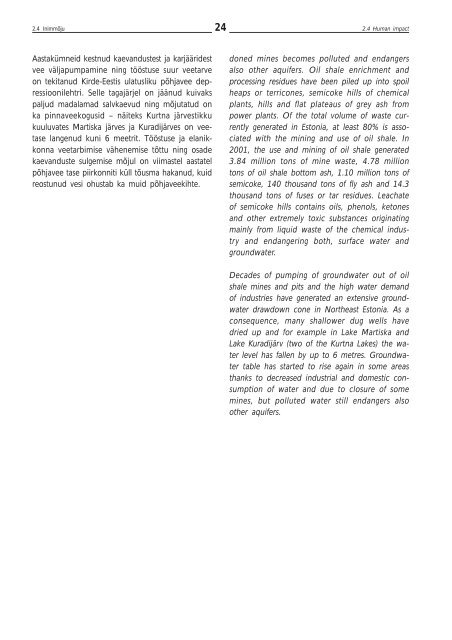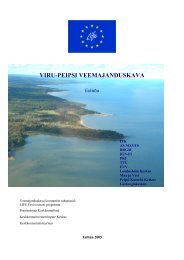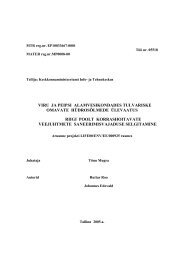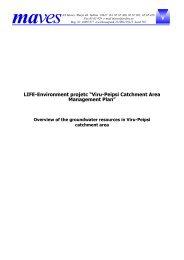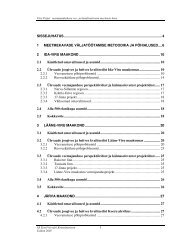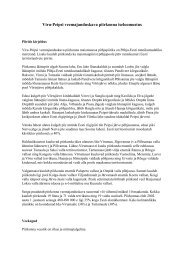Viru-Peipsi veemajanduskava - Keskkonnaministeerium
Viru-Peipsi veemajanduskava - Keskkonnaministeerium
Viru-Peipsi veemajanduskava - Keskkonnaministeerium
You also want an ePaper? Increase the reach of your titles
YUMPU automatically turns print PDFs into web optimized ePapers that Google loves.
2.4 Inimmõju<br />
24<br />
2.4 Human impact<br />
Aastakümneid kestnud kaevandustest ja karjääridest<br />
vee väljapumpamine ning tööstuse suur veetarve<br />
on tekitanud Kirde-Eestis ulatusliku põhjavee depressioonilehtri.<br />
Selle tagajärjel on jäänud kuivaks<br />
paljud madalamad salvkaevud ning mõjutatud on<br />
ka pinnaveekogusid – näiteks Kurtna järvestikku<br />
kuuluvates Martiska järves ja Kuradijärves on veetase<br />
langenud kuni 6 meetrit. Tööstuse ja elanikkonna<br />
veetarbimise vähenemise tõttu ning osade<br />
kaevanduste sulgemise mõjul on viimastel aastatel<br />
põhjavee tase piirkonniti küll tõusma hakanud, kuid<br />
reostunud vesi ohustab ka muid põhjaveekihte.<br />
doned mines becomes polluted and endangers<br />
also other aquifers. Oil shale enrichment and<br />
processing residues have been piled up into spoil<br />
heaps or terricones, semicoke hills of chemical<br />
plants, hills and flat plateaus of grey ash from<br />
power plants. Of the total volume of waste currently<br />
generated in Estonia, at least 80% is associated<br />
with the mining and use of oil shale. In<br />
2001, the use and mining of oil shale generated<br />
3.84 million tons of mine waste, 4.78 million<br />
tons of oil shale bottom ash, 1.10 million tons of<br />
semicoke, 140 thousand tons of fly ash and 14.3<br />
thousand tons of fuses or tar residues. Leachate<br />
of semicoke hills contains oils, phenols, ketones<br />
and other extremely toxic substances originating<br />
mainly from liquid waste of the chemical industry<br />
and endangering both, surface water and<br />
groundwater.<br />
Decades of pumping of groundwater out of oil<br />
shale mines and pits and the high water demand<br />
of industries have generated an extensive groundwater<br />
drawdown cone in Northeast Estonia. As a<br />
consequence, many shallower dug wells have<br />
dried up and for example in Lake Martiska and<br />
Lake Kuradijärv (two of the Kurtna Lakes) the water<br />
level has fallen by up to 6 metres. Groundwater<br />
table has started to rise again in some areas<br />
thanks to decreased industrial and domestic consumption<br />
of water and due to closure of some<br />
mines, but polluted water still endangers also<br />
other aquifers.


